The Commercial Vegetable Chopper Market is estimated to be valued at USD 269.7 million in 2025 and is projected to reach USD 380.4 million by 2035, registering a compound annual growth rate (CAGR) of 3.5% over the forecast period.
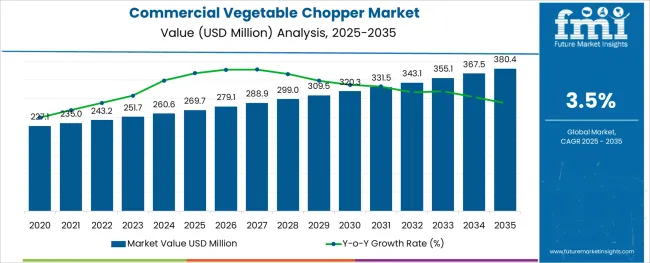
The commercial vegetable chopper market is advancing steadily as foodservice establishments, institutional kitchens, and catering businesses prioritize efficiency, consistency, and hygiene in food preparation. Increasing demand for time-saving solutions in high-volume operations has driven the adoption of advanced choppers capable of reducing manual labor and minimizing food waste.
Emphasis on food safety standards and ergonomic designs has further strengthened market adoption, with manufacturers introducing models that blend durability with ease of cleaning and operation. Looking ahead, rising investments in modernizing kitchen infrastructure, combined with the growing trend of open kitchens and live cooking experiences, are expected to support continued market growth.
Innovations in blade technology, energy-efficient motors, and user-friendly controls are paving the way for enhanced performance and broader acceptance across diverse end-user segments.
The market is segmented by Mounting Type and Technology and region. By Mounting Type, the market is divided into Countertop Vegetable Chopper and Wall-mounted Vegetable Chopper. In terms of Technology, the market is classified into Electric Vegetable Chopper, Manual Vegetable Chopper, and Other Facilities. Regionally, the market is classified into North America, Latin America, Western Europe, Eastern Europe, Balkan & Baltic Countries, Russia & Belarus, Central Asia, East Asia, South Asia & Pacific, and the Middle East & Africa.
The market is segmented by Mounting Type and Technology and region. By Mounting Type, the market is divided into Countertop Vegetable Chopper and Wall-mounted Vegetable Chopper. In terms of Technology, the market is classified into Electric Vegetable Chopper, Manual Vegetable Chopper, and Other Facilities. Regionally, the market is classified into North America, Latin America, Western Europe, Eastern Europe, Balkan & Baltic Countries, Russia & Belarus, Central Asia, East Asia, South Asia & Pacific, and the Middle East & Africa.
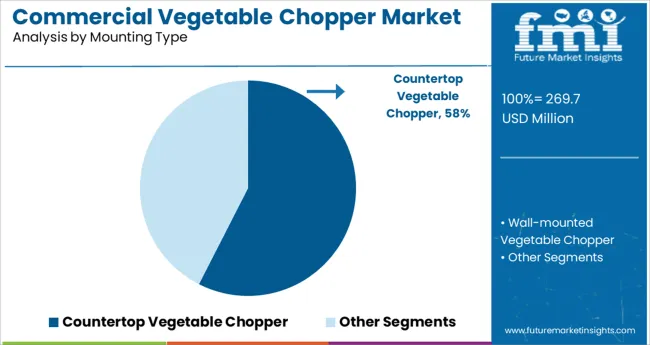
When segmented by mounting type, countertop vegetable choppers are anticipated to account for 57.5 % of the total market revenue in 2025, positioning them as the leading choice. Their dominance has been shaped by the flexibility and convenience they offer in professional kitchens where space optimization is crucial.
These units allow easy relocation and deployment across various workstations, catering to the dynamic nature of food preparation environments. Enhanced designs that integrate stability with portability have enabled operators to maintain workflow efficiency without the need for permanent installations.
Additionally, manufacturers have focused on developing compact yet powerful models that can handle large volumes without occupying excessive space, making them particularly attractive to restaurants, cafes, and catering setups where versatility and efficiency are paramount.
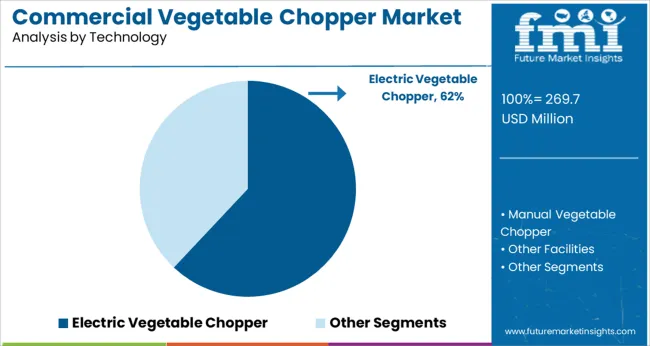
By technology, electric vegetable choppers are expected to contribute 62.0 % of the total market revenue in 2025, affirming their leadership in this category. This leading position has been driven by the ability of electric models to deliver high-speed, uniform chopping with minimal manual intervention, aligning with the operational needs of commercial kitchens.
The adoption of electric choppers has been reinforced by advancements in motor efficiency, noise reduction, and precision control, enabling chefs to process larger quantities in less time while ensuring consistent output. Furthermore, the integration of safety features and easy-to-clean components has elevated their appeal, addressing both regulatory and operational concerns.
As kitchens increasingly aim to maximize throughput while minimizing physical strain on staff, electric vegetable choppers have emerged as the preferred solution, underscoring their market leadership.
The commercial vegetable chopper market has recently seen an absolutely unexpected surge, according to information collected by Future Market Insights. With the rising demand for electric vegetable cutter machines, industry manufacturers are keeping up. Market CAGR steadily increased from 2.8% between 2020 and 2025 to 3.5% between 2025 and 2035.
The primary target audience for the commercial vegetable chopper market over the last five years has been the increased supply and demand situation in the more than 15 million restaurants that are present worldwide. In the recent past, the introduction of new vegetable-chopping technologies significantly improved the efficiency of the food supply chain. In the next five years, it is anticipated that ongoing research and development will improve the quality of these vegetable chopping machines.
The primary factor driving the expansion of the commercial vegetable chopper market over the historical period has been the ability of these machines to slice vegetables into the appropriate form without harming their natural interior tissues and nutritional worth. At present, consumers now have the liberty to choose from a wide range of commercial dicers with various grades of dicing sizes, the thickness of cut, productivity, and operating kinds. Additionally, throughout the projection period, there is likely to be considerable demand for multi-functional heavy-duty vegetable dicer that can execute the cutting, slicing, and dicing of vegetables all at once.
Industrial vegetable dicer producers can now employ sustainable materials for the blade production of these machines because of their in-depth research and development. In addition to making this machine durable, the choice of such long-lasting and sustainable materials for the blades enables it to dice various vegetable grades with no change to the general construction of the machine. This aspect is perhaps one of the main reasons why the demand for commercial vegetable choppers is increasing.
Wall-mounted Vegetable Choppers - By Mounting Type
Based on mounting type, the commercial vegetable chopper market is bifurcated into a wall-mounted vegetable chopper and a countertop vegetable chopper. The wall-mounted vegetable chopper segment dominates the market share. This segment is likely to grow at a CAGR of 3.1% during the forecast period.
Electric Vegetable Chopper - By Technology
Depending on the technology, the commercial vegetable chopper market is categorized into electric vegetable choppers, manual vegetable choppers, and others. Among these segments, the electric vegetable chopper segment holds the largest market share. The electric vegetable chopper category is expected to develop at a CAGR of 4.6% during the forecast period.
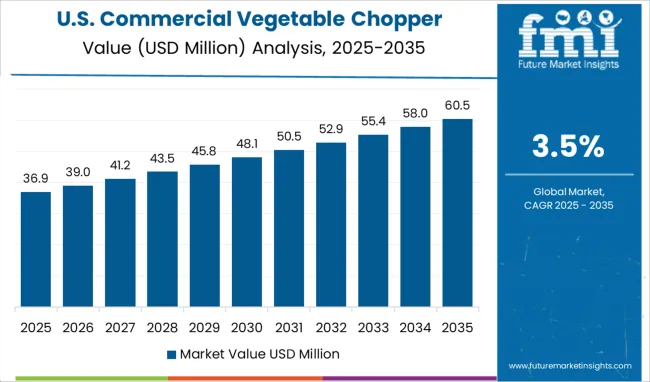
Commercial vegetable chopper sales are expected to grow significantly in North America. The United States commercial vegetable chopper market is expected to be the largest market in North America, followed by Canada.
The United States has accounted for a substantial share of the global penetration of commercial vegetable choppers. Customer satisfaction, advancement of existing chopping machines, and customization opportunities are all poised to improve the current state of industrial vegetable choppers in this country. Furthermore, the food and beverage industry in the USA is the biggest in the world. This results in the adoption of commercial cutting machines for restaurants.
The growing desire for elegant, sleek, and comfy vegetable cutters is driving product demand in the United States. Steel vegetable choppers are becoming increasingly popular since they are simple to use during chopping and have high durability. This tendency will continue to drive player innovation and new product development, fueling market expansion. Hence, the commercial vegetable chopper market in the United States is expected to develop at a CAGR of 4.2% during the forecast period, reaching a market value of USD 380.4 million by 2035.
Japan is the most significant market for commercial vegetable chopper in the Asia Pacific region. The Japanese commercial vegetable chopper market will grow faster than other markets in this region. This market is estimated to record a substantial CAGR of 9.9% during the forecast period. Increased government support for the food processing industry will boost the growth of the industrial food-cutting machines market in this nation over the projected period.
A continuous increase in the working population of Japan is also predicted to propel the commercial vegetable chopper market toward prosperity. Higher penetration and accessibility of vegetable choppers in the residential sectors of this country are driving customers to choose low and medium-priced items. However, the growing willingness of customers to spend on high-quality traditional instruments for experimenting with new cuisines, along with demand for the smart kitchen, is projected to fuel demand for the product in this nation.
New Market Participants to Encourage Innovation
The commercial vegetable chopper market provides several potentials for new firms and entrepreneurs. The sector is still in its infancy, but numerous advancements and breakthroughs are on the way. Startups in the commercial vegetable chopper sector are doing all possible to provide the finest vegetable cuts and slices. Startups are creating vegetable cutters that might be a lot of fun when it comes to prepping veggies. With these vegetable choppers, one can experiment with different cutting techniques.
Leading Startups to Keep an Eye on
| Start-up Company | Wonderchef |
|---|---|
| Country | India |
| Description | Wonderchef is a market leader in cookware and kitchen gadgets that enable customers to prepare healthy, flavorful meals with ease. Wonderchef is distinguished by German quality standards, Italian designs, and ongoing innovation. By combining beauty and usefulness, the firm adds warmth to every meal. Global trends motivate the firm to create stunning kitchen tales that bring out the culinary artist in its consumers. |
| Start-up Company | Mueller |
|---|---|
| Country | United States |
| Description | Mueller Industries enterprises have gained a well-deserved reputation for producing high-quality goods since 1917. They currently provide a diverse range of items to a global audience through their many activities and brands. Their businesses serve a wide range of markets, sectors, customers, and distribution methods. |
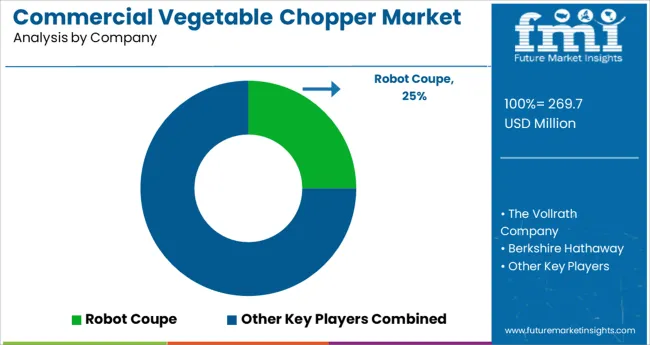
The global commercial vegetable chopper market is moderately competitive, with tier-1 players accounting for the majority of the market share. The primary strategy followed by key players in business expansion through mergers, acquisitions, collaborations, and alliances, with a focus on different approaches, such as the adoption of new technologies to develop innovative products and the enlargement of sales channels, resulting in a larger customer base.
Unleash the Horizons of Creative Vegetable Cutting with Ali Group, Nemco Food Equipment, and Sammic
Ali Group
Ali is one of the largest and most diverse global companies in the food service equipment sector. Ali Group, founded in 1963, now employs over 10,000 people in 30 countries and has 58 industrial plants globally. Ali comprises eight equipment segments: cooking, baking, food delivery and preparation, refrigeration, ware washing and waste management, ice cream and beverage dispensing, ice makers, and coffee machines.
In July 2024, Ali Group intended to acquire USA catering equipment rival Welbilt in order to improve sales as the hunger of Americans for takeout and meal delivery fuels a resurgent USA fast-food business. Ali Group stated that it couldn't pass up the opportunity to purchase brands such as Frymaster fryers, Garland grills, and Merrychef ovens, which provide fresh, hot cuisine on demand in the United States.
Nemco Food Equipment
Nemco Food Equipment is well recognized for being an inventor of novel equipment solutions that enable the normally labor-intensive production of hallmark menu items quicker and more cost-effective. In addition to its flagship food-prep equipment line, Nemco continues to develop, manufacture, and market other countertop solutions in hot-dog cooking equipment, food-merchandising equipment, and food-holding equipment, as well as ovens, toasters, boiling units, waffle and cone bakers, industrial food-waste disposers, and more.
In June 2020, Nemco Food Equipment provided a Powerkut vegetable cutter with five different styles of cuts, including spiral, ribbon, wavy ribbon, chip twister, and garnish.
Sammic
SAMMIC is a consortium of enterprises focused on the research, manufacturing, and commercialization of Equipment for the Catering and Hotel, Licensed Trade, and Food Industries. The company was founded in 1961 by local businesspeople as a maker of equipment for dynamic food preparation. Sammic's product offering has grown over time and now includes a wide range of products: ware washing, dynamic preparation, food preservation, sous-vide, and snack bar-pizzeria.
In June 2024, SAMMIC unveiled a completely redesigned line of hand blenders and whisks called XM. This new line, which is distinguished by its adaptability, ergonomics, toughness, and longevity, is the product of extensive research and development, and it strives to improve and complete the dynamic preparation family.
Recent Developments
The global commercial vegetable chopper market is estimated to be valued at USD 269.7 million in 2025.
It is projected to reach USD 380.4 million by 2035.
The market is expected to grow at a 3.5% CAGR between 2025 and 2035.
The key product types are countertop vegetable chopper and wall-mounted vegetable chopper.
electric vegetable chopper segment is expected to dominate with a 62.0% industry share in 2025.






Our Research Products

The "Full Research Suite" delivers actionable market intel, deep dives on markets or technologies, so clients act faster, cut risk, and unlock growth.

The Leaderboard benchmarks and ranks top vendors, classifying them as Established Leaders, Leading Challengers, or Disruptors & Challengers.

Locates where complements amplify value and substitutes erode it, forecasting net impact by horizon

We deliver granular, decision-grade intel: market sizing, 5-year forecasts, pricing, adoption, usage, revenue, and operational KPIs—plus competitor tracking, regulation, and value chains—across 60 countries broadly.

Spot the shifts before they hit your P&L. We track inflection points, adoption curves, pricing moves, and ecosystem plays to show where demand is heading, why it is changing, and what to do next across high-growth markets and disruptive tech

Real-time reads of user behavior. We track shifting priorities, perceptions of today’s and next-gen services, and provider experience, then pace how fast tech moves from trial to adoption, blending buyer, consumer, and channel inputs with social signals (#WhySwitch, #UX).

Partner with our analyst team to build a custom report designed around your business priorities. From analysing market trends to assessing competitors or crafting bespoke datasets, we tailor insights to your needs.
Supplier Intelligence
Discovery & Profiling
Capacity & Footprint
Performance & Risk
Compliance & Governance
Commercial Readiness
Who Supplies Whom
Scorecards & Shortlists
Playbooks & Docs
Category Intelligence
Definition & Scope
Demand & Use Cases
Cost Drivers
Market Structure
Supply Chain Map
Trade & Policy
Operating Norms
Deliverables
Buyer Intelligence
Account Basics
Spend & Scope
Procurement Model
Vendor Requirements
Terms & Policies
Entry Strategy
Pain Points & Triggers
Outputs
Pricing Analysis
Benchmarks
Trends
Should-Cost
Indexation
Landed Cost
Commercial Terms
Deliverables
Brand Analysis
Positioning & Value Prop
Share & Presence
Customer Evidence
Go-to-Market
Digital & Reputation
Compliance & Trust
KPIs & Gaps
Outputs
Full Research Suite comprises of:
Market outlook & trends analysis
Interviews & case studies
Strategic recommendations
Vendor profiles & capabilities analysis
5-year forecasts
8 regions and 60+ country-level data splits
Market segment data splits
12 months of continuous data updates
DELIVERED AS:
PDF EXCEL ONLINE
Commercial and Industrial Rotating Rack Oven Market Size and Share Forecast Outlook 2025 to 2035
Commercial Baking Rack Oven Market Size and Share Forecast Outlook 2025 to 2035
Commercial Blast Freezer Market Size and Share Forecast Outlook 2025 to 2035
Commercial Water Heater Market Size and Share Forecast Outlook 2025 to 2035
Commercial High-Speed Oven Market Size and Share Forecast Outlook 2025 to 2035
Commercial Turboprop Aircrafts Market Size and Share Forecast Outlook 2025 to 2035
Commercial Vehicle Foundation Brakes Market Size and Share Forecast Outlook 2025 to 2035
Commercial Vehicle Brake Chambers Market Size and Share Forecast Outlook 2025 to 2035
Commercial Vehicles LED Bar Lights Market Size and Share Forecast Outlook 2025 to 2035
Commercial Vehicle AMT Transmission Market Size and Share Forecast Outlook 2025 to 2035
Commercial Greenhouse Market Size and Share Forecast Outlook 2025 to 2035
Commercial Vessel Market Size and Share Forecast Outlook 2025 to 2035
Commercial Slush Machine Market Size and Share Forecast Outlook 2025 to 2035
Commercial Medium Voltage Distribution Panel Market Size and Share Forecast Outlook 2025 to 2035
Commercial Earth Observation (CEO) Market Size and Share Forecast Outlook 2025 to 2035
Commercial Ozone Generator Market Size and Share Forecast Outlook 2025 to 2035
Commercial Gas-Fired Boiler Market Size and Share Forecast Outlook 2025 to 2035
Commercial Deep Fryer Parts & Accessories Market Size and Share Forecast Outlook 2025 to 2035
Commercial Gas Restaurant Ranges Market Size and Share Forecast Outlook 2025 to 2035
Commercial Heat Pump Market Size and Share Forecast Outlook 2025 to 2035

Thank you!
You will receive an email from our Business Development Manager. Please be sure to check your SPAM/JUNK folder too.
Chat With
MaRIA